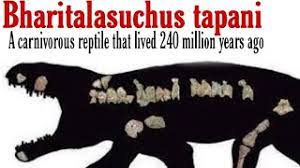Bharitalasuchus Tapani: A Carnivorous Reptile:

An international team of paleontologists has thrown light on a carnivorous reptile that lived 240 million years ago (Bharitalasuchus tapani).
- The Team studied some of the fossil specimens stored at the Indian Statistical Institute, Kolkata.
- In the mid 20th century, researchers from the Institute carried out extensive studies on rocks of the Yerrapalli Formation in what is now Telangana, uncovering several fossils.
- This reptile belongs to a genus and species previously unknown to science. They named it Bharitalasuchus tapani (BT).
- BT were robust animals with big heads and large teeth, and these probably predated other smaller reptiles.
- They were approximately the size of an adult male lion and might have been the largest predators in their ecosystems.
- In the Telugu language, Bhari means huge, Tala means head, and Suchus is the name of the Egyptian crocodile-headed deity.
- The species is named after paleontologist Tapan Roy Chowdhury in honour of his contribution to Indian vertebrate paleontology and especially his extensive work on the Yerrapalli Formation tetrapod fauna.
- Further studies revealed that the reptile belonged to a family of extinct reptiles named Erythrosuchidae.
- Erythrosuchids are known from Lower-Middle Triassic rocks of South Africa, Russia, and China, and there have been preliminary reports from the Middle Triassic Yerrapalli Formation of south-central India.




